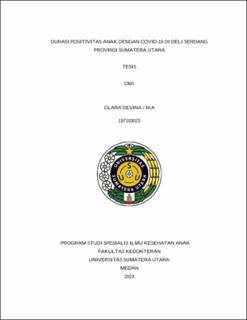Durasi Positivitas Anak dengan COVID-19 di Deli Serdang Provinsi Sumatera Utara
Positivity Rate in Children with COVID-19 in Deli Serdang, North Sumatera Province

Date
2023Author
Devina, Clara
Advisor(s)
Nasution, Badai Buana
Lubis, Inke Nadia Diniyanti
Metadata
Show full item recordAbstract
Objective :
To analyze the relationship between positivity and Ct values in children with COVID-19 in Deli Serdang, North Sumatera Province.
Method :
This research is a retrospective cohort study using secondary data to assess the duration of positivity in children with COVID-19 by RT-PCR examination of saliva specimens and nasopharyngeal swabs. Subjects were selected by consecutive sampling. After recording basic data according to the form, a nasopharyngeal swab specimen is taken while the saliva specimen is taken independently by the child who has been explained the procedure for collecting it. Nasopharyngeal swab specimens were collected weekly, while saliva specimens were collected every 3 days while clinical data and physical examination were obtained. From the data we will look for the relationship between the initial Ct value and the severity of the disease, the comparison of the positivity rate, and the Ct value duration until it becomes negative.
Result :
This research was a mass screening of 105 Islamic boarding school children. Furthermore, the results of 36 junior high school students who tested positive for RT-PCR nasopharyngeal swabs who attended Al Azhar Asy-Syarif Deli Serdang during October 2020 were followed until they showed a decrease in Ct values that could not be detected by RT-PCR. From the nasopharyngeal swab, the duration of patient positivity using the Kolmogorov-Smirnov test showed that there was a significant difference in the duration of positivity based on the initial Ct value of COVID-19 patients from the nasopharyngeal swab (p=0.017). Meanwhile, from saliva preparations, there was no significant difference in the duration of positivity based on the initial Ct value of COVID-19 patients (p=0.230).
Conclusion :
The low duration of saliva positivity indicates that the resistance of the virus in saliva in detecting SARS-CoV-2 in children is still not reliable, but can be an alternative, especially in community surveys.
Collections
- Master Theses [362]
